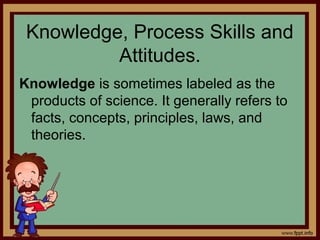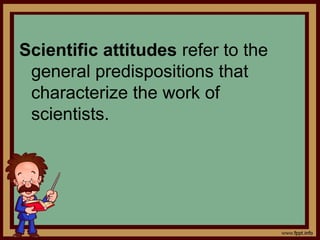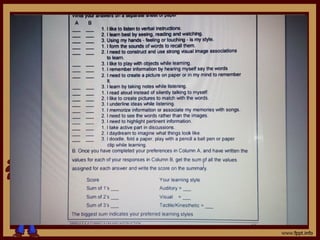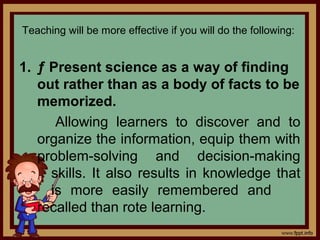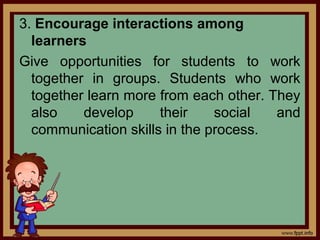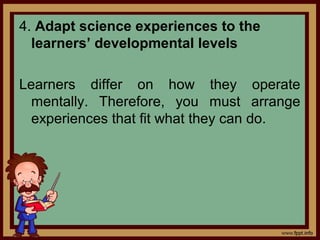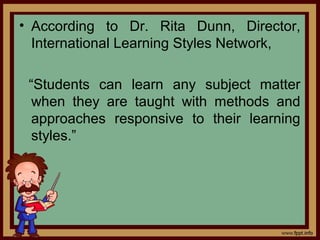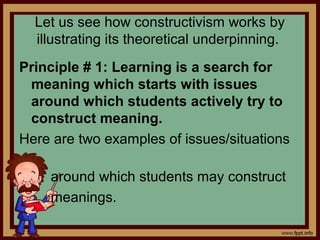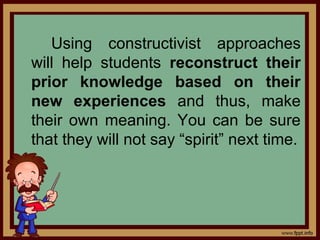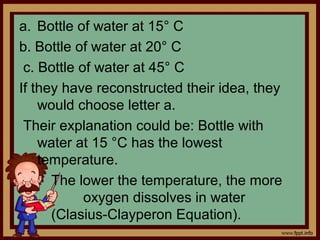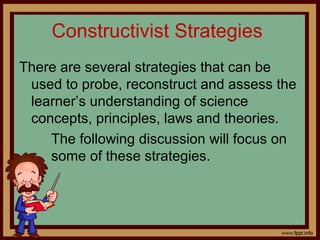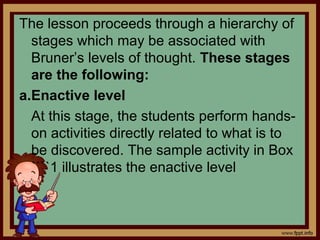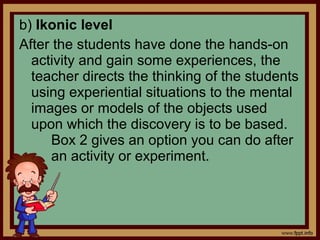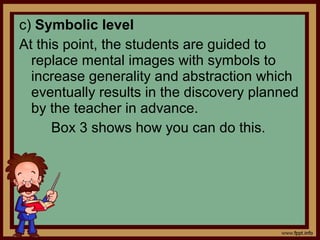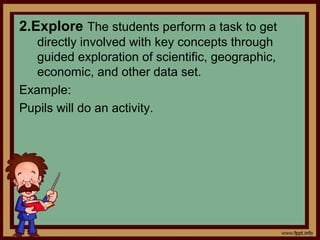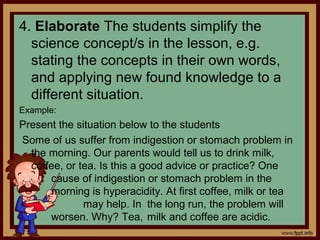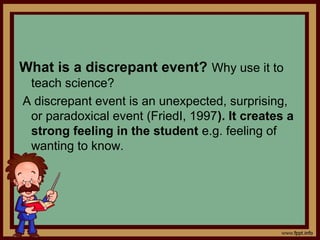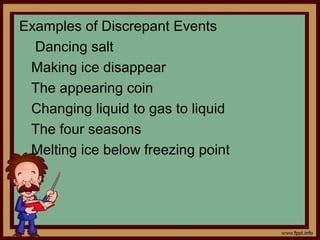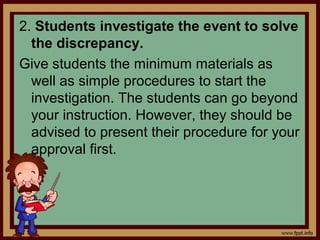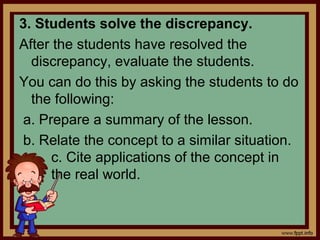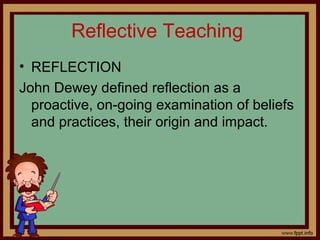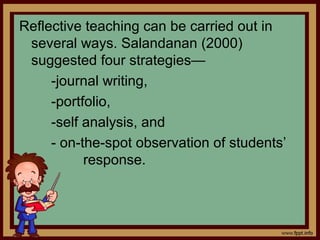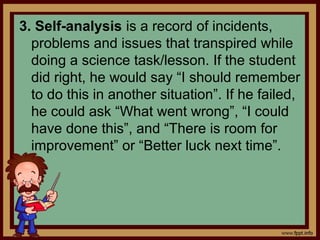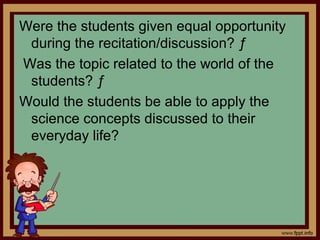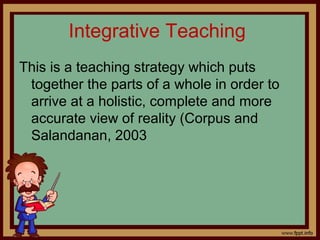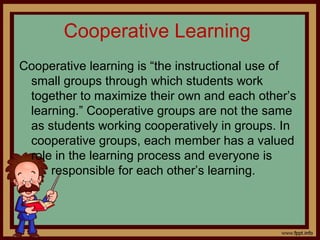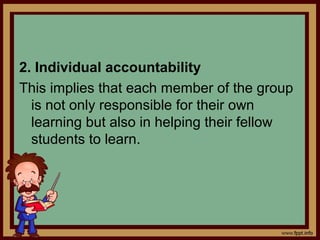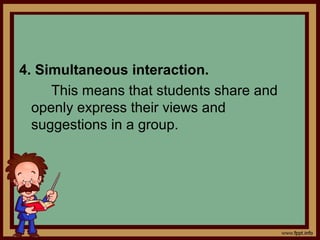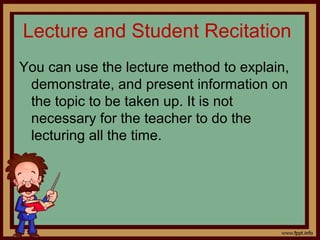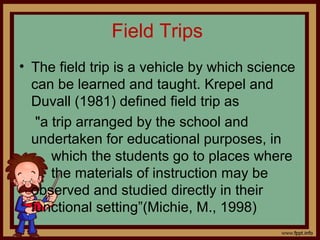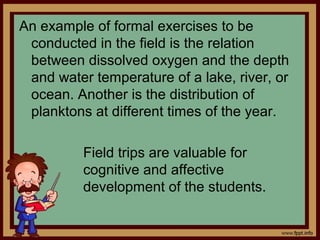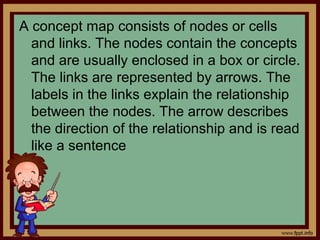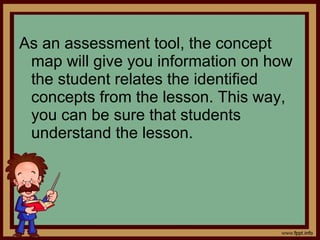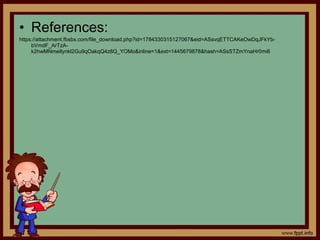Science Teaching Approaches and Strategies
- 1. Teaching Approaches and Strategies for Science
- 2. INTRODUCTION • The biggest challenge before a teacher is how to teach Science lessons. • If this teaching – learning activities are effective, students can reach the goals of life by acquisition of knowledge, skills and values in Science.
- 3. As defined by Dr. Rosalyn Yalon, a Nobel Laureate in Medicine, science is… “… not simply a collection of facts. It is a discipline of thinking about rational solutions to problems after establishing the basic facts derived from observations. It is hypothesizing from what is known to what might be and then attempting to test the hypothesis….logical thinking must come first; the facts can come later.
- 4. Knowledge, Process Skills and Attitudes. Knowledge is sometimes labeled as the products of science. It generally refers to facts, concepts, principles, laws, and theories.
- 5. Process skills are the empirical and analytic procedures used by scientists in solving problems.
- 6. Scientific attitudes refer to the general predispositions that characterize the work of scientists.
- 7. Some of the important attitudes students will have to learn and demonstrate in science include Curiosity honesty objectivity openness perseverance skepticism withholding judgment.
- 8. Characteristics of Learners which are relevant to science teaching. 1. Learners learn and develop as a whole person. The learners’ cognitive, affective, physical, social and emotional areas are intricately intertwined. Learners cannot grow in one area without affecting the other areas.
- 9. 2. Learners grow through the same predictable stages but at different rates. This means that children of the same age group may not exhibit uniform characteristics. Some may be more intellectually or socially advanced than the others in the same age group.
- 10. 3. Learners learn best through active involvement with concrete experiences. Research studies show that the use of hands-on activities can result in significant improvements in academic performance and attitude of students towards science.
- 11. 4. Learners are curious and eager to learn. When the teacher fits the learning environment to learners’ interests, needs and their levels of maturity, they become highly motivated.
- 12. 5.Learners have different learning styles. Learning styles are preferred ways that different individuals have for processing and responding to environmental stimulus (Kuchuck and Eggen, 1997). Learning styles are also referred to as cognitive styles.
- 16. Teaching will be more effective if you will do the following: 1. ƒ Present science as a way of finding out rather than as a body of facts to be memorized. Allowing learners to discover and to organize the information, equip them with problem-solving and decision-making skills. It also results in knowledge that is more easily remembered and recalled than rote learning.
- 17. ƒ 2. Emphasize learning by doing A number of researches show that learners learn better when they are personally involved in physical or hands- on activities.
- 18. 3. Encourage interactions among learners Give opportunities for students to work together in groups. Students who work together learn more from each other. They also develop their social and communication skills in the process.
- 19. 4. Adapt science experiences to the learners’ developmental levels Learners differ on how they operate mentally. Therefore, you must arrange experiences that fit what they can do.
- 20. 5. Use a variety of approaches in teaching science Students have different learning styles. To be more effective, you must be aware of their learning styles and you must consider them in choosing which teaching methods to use.
- 21. • According to Dr. Rita Dunn, Director, International Learning Styles Network, “Students can learn any subject matter when they are taught with methods and approaches responsive to their learning styles.”
- 23. STRATEGIES OF TEACHING STRATEGY: - Strategy is the art and science of directing and controlling the movements and activities of the army. If strategy is good, we can get victory over our enemies. In teaching this term is meant those procedures and methods by which objectives of teaching are realized in the class.
- 24. Constructivist Learning: A Closer Look The major theoretical point of this learning theory is that learners generate their own understanding. Learners come to school not as a blank slate but as beings with preconceptions or prior knowledge about the natural world.
- 25. Let us see how constructivism works by illustrating its theoretical underpinning. Principle # 1: Learning is a search for meaning which starts with issues around which students actively try to construct meaning. Here are two examples of issues/situations around which students may construct meanings.
- 26. a. A newly opened cold bottle of soft drink is more pleasant tasting than one that has been opened before storage in the refrigerator. b. A newly opened cold bottle of soft drink is more pleasant tasting than a newly opened bottle of soft drink at room temperature.
- 27. . If you ask your students who have not learned about Henry’s Law and Claysius Clayperon’s Equation to explain the above situations, you will probably get answers such as: “ A newly opened cold bottle of soft drink has spirit” “ A newly opened soft drink at room temperature has no spirit”
- 28. Principle # 2: Meaning requires understanding wholes as well as parts. Parts are understood in the context of wholes. Meaning requires understanding wholes as well as parts; parts can be understood in the context of wholes.
- 29. Principle # 3: In order to teach effectively, teachers must understand the mental models used by students to perceive the world and the assumptions they make to support those models. The prior mental model of the students regarding the pleasant taste of a newly opened bottle of cold soft drink is that it has ‘spirit’
- 30. From their knowledge about gases and soft drinks, the students would learn that 1.soft drinks are carbonated beverages; 2. carbon dioxide is added to the mixture at high pressure; 3. some gases are polar while others are non-polar; 1. 4. polar gases dissolve easily in water;
- 31. 5. some non-polar gases with low molecular mass such as carbon dioxide dissolve and react with water; 6. the product of this reaction is acid. This is the acid that makes soft drink pleasant in taste; and 7. pressure and temperature affect solubility of these gases in water.
- 32. Using constructivist approaches will help students reconstruct their prior knowledge based on their new experiences and thus, make their own meaning. You can be sure that they will not say “spirit” next time.
- 33. Principle # 4: The purpose of learning is for an individual to construct his/her own meaning. Thus, learning must be measured. Owing to this fact, assessment should be made part of the learning process to provide information on the quality of the students’ learning
- 34. . Going back to our example on soft drinks, you can ask this question after the lesson to find out if your students have reconstructed their ideas. Which of the containers filled with water has more oxygen? Explain your answer
- 35. a. Bottle of water at 15° C b. Bottle of water at 20° C c. Bottle of water at 45° C If they have reconstructed their idea, they would choose letter a. Their explanation could be: Bottle with water at 15 °C has the lowest temperature. The lower the temperature, the more oxygen dissolves in water (Clasius-Clayperon Equation).
- 36. Constructivist Strategies There are several strategies that can be used to probe, reconstruct and assess the learner’s understanding of science concepts, principles, laws and theories. The following discussion will focus on some of these strategies.
- 37. 1.The Discovery Approach by Jerome Bruner • You can increase the motivation of pupils to learn science if they are to experience something different from their day to day activities.
- 38. The lesson proceeds through a hierarchy of stages which may be associated with Bruner’s levels of thought. These stages are the following: a.Enactive level At this stage, the students perform hands- on activities directly related to what is to be discovered. The sample activity in Box ````1 illustrates the enactive level
- 40. b) Ikonic level After the students have done the hands-on activity and gain some experiences, the teacher directs the thinking of the students using experiential situations to the mental images or models of the objects used upon which the discovery is to be based. Box 2 gives an option you can do after an activity or experiment.
- 42. c) Symbolic level At this point, the students are guided to replace mental images with symbols to increase generality and abstraction which eventually results in the discovery planned by the teacher in advance. Box 3 shows how you can do this.
- 44. 2. Inquiry Approach • This approach teaches students to handle situations they meet in the physical world. To use the inquiry approach in the teaching of science, you need to prepare activities that will allow students to develop the following skills:
- 45. a. recognizing problems; b. asking questions; c. applying laboratory procedures; and d. providing consistent descriptions, predictions and explanations.
- 46. There are many strategies for the inquiry approach in the classroom. All inquiry strategies share common features. These are the following: a. Students do hands-on activities such as experiments. b. Students are focused on learning some analytical skills and applying the skills gained in the hands-on activities
- 47. We shall demonstrate the two ways of using inquiry -as a tool for constructivist learning - the 5-E Learning Cycle and -the Discrepant Event as springboard.
- 48. A. The 5-E Learning Cycle The 5-E Learning Cycle is a model that promotes scientific inquiry. Each “E” represents part of the process of helping students sequence their learning experiences to develop a connection between prior knowledge and new concepts. The teacher serves as a facilitator as students construct new knowledge based on thoughtful inquiry and decision making. The 5-E’s are as follows:
- 49. 1. Engage 2. Explain 3. Explore 4. Elaborate 5. Evaluate
- 50. 1. Engage The students engage in a task to make connections between the past and present learning experiences. Example: Recall the following: 1. Compounds are classified into acids, bases, and compounds. 2. Some acids and bases are strong; some are weak 3. Indicators such as litmus paper and phenolphthalein can be used to identify acids and bases. Present the situation below to your students. Suppose you want to find out which among the substances in your home are acids and bases. You don’t have any litmus paper or phenolphthalein. What will you do?
- 51. 2.Explore The students perform a task to get directly involved with key concepts through guided exploration of scientific, geographic, economic, and other data set. Example: Pupils will do an activity.
- 52. 3.Explain The students give details about the science concepts being developed in the task. Through readings and discussions, the students develop understanding of the major science concepts and verify answers to questions or problems posed in the engage stage. Example: Which of the household substances are acidic? Which substances are basic ? You can answer the questions by comparing the color change of the extract in solutions found in the second table with the color change of extract in hydrochloric acid solution/sodium hydroxide solution. From these two tables you can deduce that milk, tea, coffee and bleaching agent are acids. Shampoo, detergent, baking soda and toothpaste are bases.
- 53. 4. Elaborate The students simplify the science concept/s in the lesson, e.g. stating the concepts in their own words, and applying new found knowledge to a different situation. Example: Present the situation below to the students Some of us suffer from indigestion or stomach problem in the morning. Our parents would tell us to drink milk, coffee, or tea. Is this a good advice or practice? One cause of indigestion or stomach problem in the morning is hyperacidity. At first coffee, milk or tea may help. In the long run, the problem will worsen. Why? Tea, milk and coffee are acidic.
- 54. 5. Evaluate The students take a test, quiz, or any authentic assessment instrument to determine how much they benefited from the lesson or activity.
- 55. B. Discrepant Event as Springboard for Inquiry Learning
- 56. What is a discrepant event? Why use it to teach science? A discrepant event is an unexpected, surprising, or paradoxical event (FriedI, 1997). It creates a strong feeling in the student e.g. feeling of wanting to know.
- 57. There are three steps to follow when using the discrepant event strategy. They are as follows: 1. Set up a discrepant event. Present the event to gain attention, increase motivation, and encourage the students to seek ways of solving the unexpected. Some examples of discrepant events are shown below.
- 58. Examples of Discrepant Events Dancing salt Making ice disappear The appearing coin Changing liquid to gas to liquid The four seasons Melting ice below freezing point
- 59. 2. Students investigate the event to solve the discrepancy. Give students the minimum materials as well as simple procedures to start the investigation. The students can go beyond your instruction. However, they should be advised to present their procedure for your approval first.
- 60. 3. Students solve the discrepancy. After the students have resolved the discrepancy, evaluate the students. You can do this by asking the students to do the following: a. Prepare a summary of the lesson. b. Relate the concept to a similar situation. c. Cite applications of the concept in the real world.
- 61. Reflective Teaching • REFLECTION John Dewey defined reflection as a proactive, on-going examination of beliefs and practices, their origin and impact.
- 62. Reflective Teaching How are your students benefited by reflective teaching? Reflective practice helps students do the following: ƒ 1. frame a problem, detach from it and analyze it critically; ƒ 2. bridge the gap between theory and practice; ƒ 3.understand and influence their own thinking; ƒ 4. recognize the depth and range of transferable skills learned; and ƒ -become life-long learners.
- 63. Reflective teaching can be carried out in several ways. Salandanan (2000) suggested four strategies— -journal writing, -portfolio, -self analysis, and - on-the-spot observation of students’ response.
- 64. 1.Journal writing allows the students to reflect or process their thoughts about science concepts. Journals may be in the form of workbooks, diaries, logs ,or progress profiles. Journals make students look back over their recent learning
- 65. 2. The portfolio is a personal record which includes honest to goodness account of experiences - thoughts, behavior and reactions.
- 66. 3. Self-analysis is a record of incidents, problems and issues that transpired while doing a science task/lesson. If the student did right, he would say “I should remember to do this in another situation”. If he failed, he could ask “What went wrong”, “I could have done this”, and “There is room for improvement” or “Better luck next time”.
- 67. 4. The fourth strategy for reflective teaching is on the spot observation of the students’ responses. As a teacher, ask yourself the following questions so that you can reflect on the lessons just conducted: ƒ Were the students motivated to participate in the activity? ƒ Did the students take part in the discussion? ƒ Did the students share their views animatedly?
- 68. Were the students given equal opportunity during the recitation/discussion? ƒ Was the topic related to the world of the students? ƒ Would the students be able to apply the science concepts discussed to their everyday life?
- 69. Integrative Teaching This is a teaching strategy which puts together the parts of a whole in order to arrive at a holistic, complete and more accurate view of reality (Corpus and Salandanan, 2003
- 70. It is infused by the multiple intelligences, the varied learning styles and the daily experiences of the learners. It empowers learners to become lifelong learners and active makers of meaning.
- 71. Integrative teaching is a three-level strategy – the facts level, - the concept level and - the values level.
- 72. Integrative teaching involves the practice of recognizing and articulating relationships among subject matters and applying learning from one context to another. It also involves building bridges between the academe and the wider world, between public issues and personal experience.
- 73. Advantages of Integrative Teaching ƒ 1. makes content more meaningful because the content is presented the way it is in the real world ƒ2. is student-centered, involves active learning with the teacher acting as facilitator of learning ƒ 3.allows learners to form their own representations of complex topics and issues
- 74. ƒ 4.offers multiple ways for learners to demonstrate the knowledge, skills and attitudes learned ƒ gives opportunities for students to work in a context where interdependence and cooperation are crucial for getting things done ƒ helps learners develop a variety of social skills
- 75. Cooperative Learning Cooperative learning is “the instructional use of small groups through which students work together to maximize their own and each other’s learning.” Cooperative groups are not the same as students working cooperatively in groups. In cooperative groups, each member has a valued role in the learning process and everyone is responsible for each other’s learning.
- 76. There are four basic components of cooperative learning. They are as follows: ƒ 1.Positive interdependence This principle emphasizes that the success or failure of the group depends on the success or failure of each member. Thus, each member of the group learns to share and work together to attain the shared goal.
- 77. 2. Individual accountability This implies that each member of the group is not only responsible for their own learning but also in helping their fellow students to learn.
- 78. 3. Equal participation This means that each member has his/her own role, work or load to achieve the goal of the group. No member should be allowed to dominate anybody in the group either socially or academically
- 79. 4. Simultaneous interaction. This means that students share and openly express their views and suggestions in a group.
- 80. Here are some tips that will help you implement cooperative learning successfully. ƒ Be sure to monitor the group and their activities, taking care to ensure that the groups are functioning as groups and that one student is not dominating the work. ƒ 1. Give credit to the teams for their collective work, not the work of one individual. ƒ 2 Rotate the roles among the members of the group. 3. Create a new group every now and then.
- 81. Lecture and Student Recitation You can use the lecture method to explain, demonstrate, and present information on the topic to be taken up. It is not necessary for the teacher to do the lecturing all the time.
- 82. Role Playing and Simulation • Role playing can be used to dramatize the situations
- 83. Example: Everyday we encounter situations where people are in conflict or faced with a dilemma of some sort. Take the need to have a supply of wood for construction material as an example. This means trees have to be cut from the forests. However, our forest cover is getting smaller. So, we are faced with a dilemma, “Are we going to ban logging completely?” or “Are we going to practice selected logging?”
- 84. Simulation • Pupils are placed in a situation that models a real life phenomenon.
- 85. For example Barangay A has a population of ten thousand ((10,000). One pressing problem of the barangay is a build up of mountains of garbage. If a person produces three (3) kilograms of garbage everyday how soon can a barangay accumulate a mountain of garbage with a bulk of 20,000,000 kilograms of garbage?
- 86. Field Trips • The field trip is a vehicle by which science can be learned and taught. Krepel and Duvall (1981) defined field trip as "a trip arranged by the school and undertaken for educational purposes, in which the students go to places where the materials of instruction may be observed and studied directly in their functional setting”(Michie, M., 1998)
- 87. An example of formal exercises to be conducted in the field is the relation between dissolved oxygen and the depth and water temperature of a lake, river, or ocean. Another is the distribution of planktons at different times of the year. Field trips are valuable for cognitive and affective development of the students.
- 88. Field trips provide the opportunity for hands- on, real world experiences, improved quality of education, motivation and development of positive attitude towards the subject, improvement of the socialization between students as well as development of rapport between teachers and students.
- 89. Concept Mapping A concept map is a special form of a web diagram for exploring knowledge and gathering and sharing information. Concept mapping is employed to develop connections among concepts in the unit.
- 90. A concept map consists of nodes or cells and links. The nodes contain the concepts and are usually enclosed in a box or circle. The links are represented by arrows. The labels in the links explain the relationship between the nodes. The arrow describes the direction of the relationship and is read like a sentence
- 92. As an assessment tool, the concept map will give you information on how the student relates the identified concepts from the lesson. This way, you can be sure that students understand the lesson.
- 93. Games Children love to play games. Games can teach children to work together as a well- coordinated team. It develops coordination skills which are necessary to perform delicate jobs..
- 94. Basketball can be used to teach motion in physics. Billiards can be used to develop functional understanding about momentum. Tug-of-war is a good analogy for developing concepts about balanced or unbalanced forces either in physics or chemistry
- 95. • Puzzles, cartoons, humor, magic, and jokes can also be used in the science classrooms. They make science learning fun and enjoyable for learners.
Editor's Notes
- #2: Good morning! I task to share to you some of the Teaching approaches and strategies for Science
- #3: As a science teacher, we play a very significant role in preparing our children to become lifelong learners, a quality that will enable them to meet the challenges in this fast changing world. It is important to bear in mind that what you choose to teach in science and how you teach it will be influenced by your views of both science and the children. To gain a better understanding of what you should teach in science, let us first define what science is.
- #4: In this definition, we can say that science teaching has three interacting facets, namely: knowledge, process skills and attitudes. (Facets-one side or aspect)
- #6: Competence in using these skills provide children with the ability to apply knowledge not only to science and other subject areas in the classroom but also to their daily lives outside the classroom. Once your students learn to use the science process skills to solve problems, you can be sure that they will become lifelong learners. For this reason, the science process skills have been called lifelong learning skills. (empirecal –derived from experiment and observation rather than theory)
- #8: as a science teacher, we should not only be concerned with what science is all about. We should also see to it that our students develop the different basic process skills and scientific attitudes. (Skeptic –doubt)
- #9: As a teacher, bear in mind that we are responsible for the development of the whole individual, not just one or two particular areas of his/her development.
- #10: ,as a teacher we should make allowances or provisions for the differences that may be found among your students. Kaya nga minsan may activity tayo para sa slow at fast learners para lahat ay nakaka adopt
- #11: Hands-on approaches to teaching science is consistent with the philosophy of learning and instruction called constructivism. .. According to the constructivist’s point of view, learners are not passive recipients of knowledge; rather, they are active constructors and re-constructors of their own understanding. Constructivists view learning as creating new knowledge and deriving meanings by combining incoming information with what they already know.
- #12: If Their curiosity and desire to learn are enhanced. Learners learn best what is meaningful to them. They learn best in an environment that is natural, relaxed and free of competitive elements rather than in settings that are highly structured and tightly organized
- #13: Each student has his/her own learning style…Some of your students may learn best through visual mode, others are primarily aural, tactile or kinesthetic learners. Some like to work alone rather than with others; some like to be given tasks that are structured for them rather than to be asked to develop their own structures. …To have an idea of the learning styles of your students. You may use the Perceptual Strength Inventory devised by Dunn and Dunn .
- #15: Based on the Perceptual Strength Inventory that you have accomplished, what is your learning style? Administering the inventory to your students will give you an idea of their preferred learning modalities. While some students may have two or more preferred learning modalities, each has a distinct perceptual strength. Table 1.1 gives the characteristics of learners according to each type of learning modalities espoused by Dunn and Dunn.
- #16: With the characteristics of learners in mind, your teaching will be more effective if you do the following:
- #17: Learners can do this when we give simple experiment to them.
- #18: The science process skills, for example, can only be taught through experiencing science. These skills are not developed by reading, listening to lectures, watching demonstrations, videos or movies or working with the computer. The thrill of science can only be fully realized through direct involvement of the learner.
- #20: Providing experiences that are appropriate to your pupils’ developmental level will result in better learning and achievement. It will also give students a feeling of success.
- #22: This implies that for your teaching to be more effective, you should be sensitive to your students learning styles. How you deliver your lesson relates proportionally to how your students store, process and retrieve information. Better performance will result when you match your teaching styles to the learning styles of your students.
- #23: you may have diverse students with individual preferences for learning; therefore, you have to employ different teaching strategies. Your choice of teaching strategy should take into account such factors as the skills to be developed for a particular class session, learning abilities and learning styles of your students, available facilities, and time allotment for the lesson.
- #25: Contemporary science instruction has become highly constructive in nature. It has shifted from an emphasis on acquiring content knowledge to the process of constructing scientific understanding.
- #29: example, when you take up topics on gases, your students will learn some principles about them. Eventually, they would use specific principles about gases to explain the pleasant taste of a newly opened cold bottle of soft drink.
- #31: one end of the molecule has a positive electrical charge and the other side has a negative charge. If this is the case, the molecule is called a polar molecule, meaning that it has electrical poles. Otherwise, it is called a non-polar molecule.
- #32: So, do not get offended by the answer “spirit”.
- #38: In using discovery approach, the teacher decides, in advance, the concept, process, law or piece of scientific knowledge which is to be “discovered” or un-covered by the pupils.
- #56: Have you seen or heard of an iceberg in Manila Bay? An iceberg in Manila Bay is a discrepant event. Why? Manila, Philippines is close to the equator and the temperature never reaches the freezing point.
- #57: . This feeling creates a condition favorable for inquiry learning. Its use in science capitalizes on the curiosity of students and it leads them to better understanding of science (Paradoxical - statement that seems to contradict itself but may nonetheless be true)
- #62: The practitioners of reflection engage in a cycle of observation and self-evaluation in order to understand their own actions and the reactions they prompt on themselves and learners. Reflection can be seen as consciously thinking about analyzing what has been done and what one has done or is doing (Salandanan, 2000).
- #63: Reflecting on how you developed a science concept a week or two days ago is important to the improvement of the next teaching session. It makes you a better facilitator of science learning. In turn, students acquire meaningful experience of forthcoming science lessons.
- #65: In doing so, they can identify their strengths, weaknesses, new levels of understanding about the lesson at hand, and review their attitude towards the latest science concepts learned. The journal entry includes a description of the learning event, outcomes of the event, worthiness of outcome and causes of failure or success.
- #66: This record gives insights to students’ learning for a particular science topic. Portfolios may contain a collection of students’ work such as homework, projects, written pieces, graphic organizers, tests, reflections, and other artifacts.
- #69: Do not rely solely on the natural process of reflecting on experience. Instead, you should actively find ways to make reflection a habit. By doing so, you ensure your continuing development as a professional teacher. Reflecting on your own past performance is one form of feedback. Keeping a reflective diary about your own experiences with your class, students and colleagues, helps you to reflect and learn from experience.
- #72: Students pick up fragmented terms or facts at facts level. Here, the students move to the concept level when they view and organize the isolated, fragmented and meaningless facts into concepts. Then, the knowledge acquired is applied to the learners’ life at the values level.
- #76: Students take time to reflect on their personal contributions to the group, on how members perform, and on how the group may improve.
- #83: Majority of the class members observe and analyze the components of enactment. After the role play, discussion follows. Example….
- #92: Notice that the concepts are linked by lines and there are link words between concepts to show the relationship. A concept map can be a group work or an individual activity.



